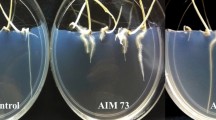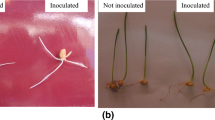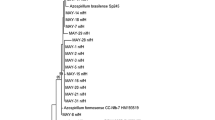Abstract
Biological nitrogen fixation (BNF) is highly effective in the field and potentially useful to reduce adverse effects chemical fertilisers. Here, Azotobacter species were selected via phenotypic, biochemical and molecular characterisations from different rice fields. Acetylene reduction assay of Azotobacter spp. showed that Azotobacter vinelandii (Az3) fixed higher amount of nitrogen (121.09 nmol C2H4 mg-1 bacteria h-1). Likewise, its plant growth functions, viz. siderophore, hydrogen cyanide, salicylic acid, IAA, GA3, zeatin, NH3, phosphorus solubilisation, ACC deaminase and iron tolerance, were also higher. The profile of gDNA, plasmid DNA and cellular protein profile depicted inter-generic and inter-specific diversity among the isolates of A. vinelandii. The PCR-amplified genes nifH, nifD and nifK of 0.87, 1.4 and 1.5 kb , respectively, were ascertained by Southern blot hybridisation in isolates of A. vinelandii. The 16S rRNA sequence from A. vinelandii (Az3) was novel, and its accession number (JQ796077) was received from NCBI data base. Biofertiliser formulation of novel A. vinelandii isolates along with commercial one was evaluated in rice (Oriza sativa L. var. Khandagiri) fields. The present finding revealed that treatment T4 (Az3) (A. vinelandii) are highly efficient to improved growth and yield of rice crop.




Similar content being viewed by others
References
Akhter MS, Hossain SJ, Amir-Hossain SK, Datta RK (2012) Isolation and characterization of salinity tolerant Azotobacter sp. Greener J Biol Sci 2:42–051
Banerjee A, Padhi S, Adhya TK (1999) Persistence and biodegradation of vinclozolin in tropical rice soils. Pest Sci 55:1177–1181
Barua S, Tripathi S, Chakraborty A, Ghosh S, Chakrabarti K (2012) Characterization and crop production efficiency of diazotrophic bacterial isolates from coastal saline soils. Microbiol Res 167:95–102
Bashan Y, de-Bashan LE (2010) How the plant growth-promoting bacterium Azospirillum promotes plant growth—a critical assessment. Adv Agron 108:77–136
Bhaduri S, Demchick PH (1983) Simple and rapid method for disruption of bacteria for protein studies. Appl Environ Microbial 46:941–943
Bhattacharjee RB, Singh A, Mukhopadhyay SN (2008) Use of nitrogen-fixing bacteria as biofertilizer for non-legumes: prospects and challenges. Appl Microbiol Biotechnol 80:199–209
Bhattacharyya P, Roy KS, Neogi S, Adhya TK, Rao KS, Manna MC (2012) Effects of rice straw and nitrogen fertilization on greenhouse gas emissions and carbon storage in tropical flooded soil planted with rice. Soil Till Res 124:119–130
Bohme L, Langer U, Bohme F (2005) Microbial biomass, enzyme activities and microbial community structure in two European long-term field experiments. Agric Ecosyst Environ 109:141–152
Chapman HD, Pratt PF (1982) Method and of analysis of soil, plant and water, 2nd edn. California University Agricultural Division, California, p 170
Chaudry IA, Cornfield AH (1966) The determination of total sulfur in soil and plant material. Analyst 91:528–530
Choudhury ATMA, Kennedy IR (2004) Prospects and potentials for systems of biological nitrogen fixation in sustainable rice production. Biol Fertil Soils 39:219–227
Collee JG, Miles PS (1989) Tests for identification of bacteria. In: Collee JG, Duguid JP, Fraser AG, Marmion BP (eds) Practical medical microbiology. Churchil Livingstone, NY, USA, pp 141–160
Govindan M, Bagyaraj DJ (1995) Field response of wetland rice to Azospirillum inoculation. J Soil Biol Ecol 15:17–22
Haefele SM, Wopereis MCS, Schloebohm AM, Wiechmann H (2004) Long-term fertility experiments for irrigated rice in the West African Sahel: effect on soil characteristics. Field Crops Res 85:61–77
Hanlon EA, Devore JM (1989) IFAS extension soil testing laboratory chemical procedures and training manual. Circ. No. 812. Fla. Coop. Ext. Ser., IFAS, Univ. Of Florida, Gainesville, FL
Hardy RWF, Holsten RD, Jackson EK, Burns RC (1968) The acetylene–ethylene assay for N2 fixation: laboratory and field evaluation. Plant Physiol 43:1185–1207
Hayat R, Ali S, Amara U, Khalid R, Ahmed I (2010) Soil beneficial bacteria and their role in plant growth promotion: a review. Ann Microbiol 60:579–598
Hill S, Sawers G (2000) Azotobacter. In: Lederberg J (ed) Enclyopedia of microbiology, vol 1A–C. Acad Press, NY, pp 359–371
Hong JS, Geun TP, Mi SC, Moon SH (2006) Solubilization of insoluble inorganic phosphates by a novel salt- and pH-tolerant Pantoea agglomerans R-42 isolated from soybean rhizosphere. Biores Technol 97:204–210
Jackson TL (1973) Soil chemical analysis. Prentice-Hall, New Delhi, India
Jen-Hshuan C (2006) The combined use of chemical and organic fertilizers and/or biofertilizer for crop growth and soil fertility. Int Work Sustained Manag Soil-rhizosphere Syst Efficient Crop Prod Fertil Use 16:1–10
Jensen HL (1954) The Azotobacteriaceae. Bacteriol Rev 18:195–214
Jimenez DJ, Montana JS, Martinez MM (2011) Characterization of free nitrogen fixing bacteria of the genus Azotobacter in organic vegetable-grown colombian soils. Braz J Microbiol 42:846–858
Kader MA, Mamun SMA, Hossain SMA, Hasna MK (2000) Effect of Azotobacter application on the growth and yield of transplanted aman rice and nutrient status of post-harvest soil. Pakistan J Biol Sci 3:1144–1147
Kanimozhi K, Panneerselvam (2011) A Investigation of soil characters and Azospirillum isolated from paddy soils of Thanjavur district, East Coast of Tamilnadu, India. Arch Appl Sci Res 3:525–536
Kannan T, Ponmurugan P (2010) Response of paddy (Oryza sativa L.) varieties to Azospirillum brasilense inoculation. J Phytol 2:8–13
Kanungo PK, Panda D, Adhya TK, Ramakrishnan B, Rao VR (1997) Nitrogenase activity and nitrogen-fixing bacteria associated with rhizosphere of rice cultivars with varying N absorption efficiency. J Sci Food Agric 73:485–488
Karadeniz A, Topcuoglu SF, Inan S (2006) Auxin, gibberellin, cytokinin and abscisic acid production in some bacteria. World J Microbiol Biotechnol 22:1061–1064
Kennedy IR, Tcha YT (1992) Biological nitrogen fixation in non-leguminous field crops: recent advances. Plant Soil 141:93–118
Kennedy C, Rudnick P, MacDonald ML, Melton T (2005) Genus III. Azotobacter. In: Brenner DJ, Krieg NR, Staley JT (eds) Bergey’s manual of systematic bacteriology, vol 2B. Springer, New York, USA, pp 384–402
Keyeo F, Noor O, Amir HG (2011) The effects of nitrogen fixation activity and phytochrome production of diazotroph in promoting growth of rice seedlings. Biotechnology 10:267–273
Khan MR, Talukdar NC, Thakur D (2003) Detection of Azospirillum and PSB in rice rhizosphere soil by protein and antibiotic resistance profile and their effect on grain yield of rice. Ind J Biotechnol 2:246–250
Kluepfel DA (1993) The behaviour and tracking of bacteria in the rhizosphere. Annu Rev Phytopathol 31:441–472
Kumar K, Kannaiyan S (2006) In: John William S (ed) Molecular characterization of nif genes of heterotrophic and endophytic diazotrophs in rice. Biodiversity: life to our mother earth, Chennai, India, p 467
Kyriazakis I, Oldham JD (1993) Diet selection in sheep: the ability of growing lambs to select a diet that meets their crude protein (nitrogen × 6.25) requirements. Br J Nutr 69:617–629
Li JC, Shi J, Zhao XL, Wang GYU, Ren YJ (1994) Separation and determination of three kinds of plant hormone by high performance liquid chromatography. Chin J Anal Chem 22:801–804
Macmillan J, Suter PJ (1963) Thin-layer chromatography for the gibberellins. Nature London 197:790
Malik KA, Rakhshanda B, Samina M, Rasul G, Mirza MS, Ali S (1997) Association of nitrogen-fixing, plant-growth promoting rhizobacteria (PGPR) with kallar grass and rice. Plant Soil 194:37–44
Marianna M, Szilvia V, Eva G, Nora B, Brigitta T, Laszlo L (2005) The possible role of biofertilizers in agriculture. Ratarstvo 12:585–588
Meng L, Ding WX, Cai ZC, Qin SW (2005) Storage of soil organic C and soil respiration as affected by long-term quantitative fertilization (in Chinese). Adv Earth Sci 20:687–692
Mot RD, Vanderhyden J (1989) Application of two-dimensional protein analysis for strain finger printing and mutant analysis of Azospirillum sp. Can J Microbiol 35:960–967
Nayak DR, Jagadeeshbabu Y, Adhya TK (2007) Long-term application of compost influences microbial biomass and enzyme activities in a tropical aeric endoaquept planted to rice under flooded condition. Soil Biol Biochem 39:1897–1906
Needleman BA, Gburek WJ, Sharpley AN, Peterson GW (2001) Environmental management of soil phosphorus: Modeling spatial variability in small fields. Soil Sci Soc Am J 65:1516–1522
Patel PH, Patel JP, Bhatt SA (2013) Characterization and phylogenetic relatedness of Azotobacter Salinestris. J Microbiol Biotechnol Res 3:65–70
Pathak H, Byjesh K, Chakrabarti B, Aggarwal PK (2011) Potential and cost of carbon sequestration in Indian agriculture:estimates from long-term field experiments. Field Crops Res 120:102–111
Patil V (2011) Production of indole acetic acid by Azotobacter sp. Recent Res Sci Technol 3:14–16
Pedraza RO, Bellone CH, de-Bellone SC, Sorte PMFB, Teixeira KRDS (2009) Azospirillum inoculation and nitrogen fertilization effect on grain yield and on the diversity of endophytic bacteria in the phyllosphere of rice rainfed crop. Eur J Soil Biol 45:36–43
Perrig D, Boiero ML, Masciarelli OA, Penna C, Ruiz OA, Cassan FD, Luna MV (2007) Plant-growth-promoting compounds produced by two agronomically important strains of Azospirillum brasilense, and implications for inoculants formulation. Appl Microbiol Biotechnol 75:1143–1150
Prajapati K, Yami KD, Singh A (2008) Plant growth promotional effect of Azotobacter chroococcum, Piriformospora indica and vermicompost on rice plant. Nepal J Sci Technol 9:85–90
Rai M (2004) International year of rice—an overview. Indian Farming 54:3–6
Rajaee S, Alikhani HA, Raiesi F (2007) Effect of plant growth promoting potentials of Azotobacter chroococcum native strains on growth, yield and uptake of nutrients in wheat. J Sci Technol Agric Nat Resour 11:285–297
Reddy BP, Reddy KRN, Rao MS, Rao KS (2008) Efficacy of antimicrobial metabolites of Pseudomonas fluorescens against rice fungal pathogens. Curr Trends Biotechnol Pharm 2:178–182
Saharan BS, Nehra V (2011) Plant growth promoting rhizobacteria: a critical review. Life Sci Med Res 21:1–30
Sahrawat KL (2000) Macro and micronutrients removed by upland and lowland rice cultivars in West Africa. Commun Soil Sci Plant Anal 31:717–723
Saikia SP, Jain V (2007) Biological nitrogen fixation with non-legumes: an achievable target or a dogma? Curr Sci 92:317–322
Sambrook J, Fritsch EF, Maniatis T (1989) Molecular cloning: a laboratory manual, 2nd edn. Cold Spring Harbor Laboratory Press, Cold Spring Harbor, New York
Samuel S, Muthukkaruppan SM (2011) Characterization of plant growth promoting rhizobacteria and fungi associated with rice, mangrove and effluent contaminated soil. Curr Bot 2:22–25
Seck PA, Diagne A, Mohanty S, Wopereis MCS (2012) Crops that feed the world 7: rice. Food Sec 4:7–24
Setubal JC et al (2009) Genome sequence of Azotobacter vinelandii, an obligate aerobe specialized to support diverse anaerobic metabolic processes. J Bacteriol 191:4534–4545
Shrestha RK, Maskey SI (2005) Associative nitrogen fixation in lowland rice. Nepal Agric Res J 6:112–121
Singh MS (2006) Cereal crops response to Azotobacter—a review. Agric Rev 27:229–231
Smibert R, Krieg NR (1995) Phenotypic characterization. In: Gerhardt P, Murray RGE, Wood W, Krieg E (eds) Methods for general and molecular bacteriology. American Society for Microbiology, Washington DC, pp 607–654
Strzelczyk E, Kampert M, Li CY (1994) Cytokinin like substances and ethylene production by Azospirillum in media with different carbon sources. Microbiol Res 149:55–60
Subba Rao NS (2007) Soil microorganisms and plant growth. Oxford IBH publication, New Delhi
Syono K, Newcomb W, Torrey JG (1976) Cytokinin production in relation to the development of pea root nodules. Can J Bot 54:2155–2162
Tejera N, Luch C, Martinez-Toledo MV, Gonzalez-Lopez J (2005) Isolation and characterization of Azotobacter and Azospirillum strains from the sugarcane rhizosphere. Plant Soil 270:223–232
Tien TM, Gaskins MH, Hubbell DH (1979) Plant growth substances produced by Azospirillum brasilense and their effect on the growth of pearl millet (Pennisetum americanum L.). Appl Microbiol 37:1016–1024
Upper CD, Helgeson JP, Kemp JD, Schmidt CJ (1970) Gas–liquid chromatographic isolation of cytokinins from natural sources: 6-(3-methyl-2-butenylamino) purine from Agrobacterium tumefaciens. Plant Physiol 45:543–547
Vessey JK (2003) Plant growth promoting rhizobacteria as biofertilizers. Plant Soil 255:571–586
You CB, Song N, Wang HX, Li JP, Lin M, Hai WL (1991) Association of Alcaligenes faecalis with wetland rice. Plant Soil 137:81–85
Yushmanov SV, Chumakov KM (1988) Algorithms of the maximum topological similarity phylogenetic trees construction. Mol Genet Microbiol Virusol 3:9–15
Zaki N, Gomaa AM, Galal A, Farrag AA (2009) The associative impact of certain diazotrophs and farmyard manure on two rice varieties grown in a newly cultivated land. Res J Agric Biol Sci 5:185–190
Acknowledgments
Work on plant stress tolerance in NT’s Laboratory is partially supported by the Department of Science and Technology (DST) and Department of Biotechnology (DBT), Government of India.
Conflict of interest
None
Author information
Authors and Affiliations
Corresponding author
Additional information
Handling Editor Bhumi Nath Tripathi
Rights and permissions
About this article
Cite this article
Sahoo, R.K., Ansari, M.W., Dangar, T.K. et al. Phenotypic and molecular characterisation of efficient nitrogen-fixing Azotobacter strains from rice fields for crop improvement. Protoplasma 251, 511–523 (2014). https://doi.org/10.1007/s00709-013-0547-2
Received:
Accepted:
Published:
Issue Date:
DOI: https://doi.org/10.1007/s00709-013-0547-2




